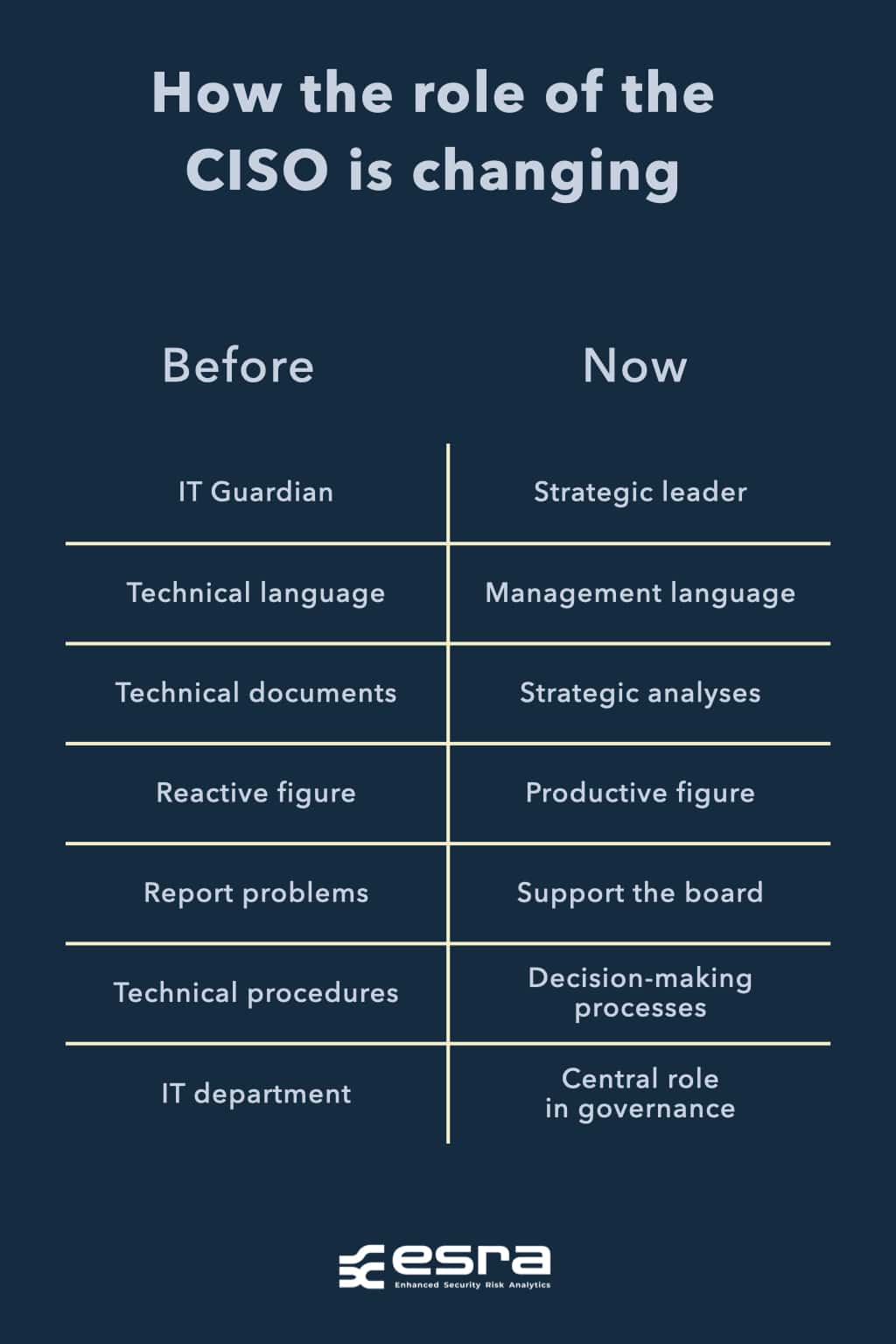
Cyber risk has now become an integral part of the agendas of boards of directors.
The topic is no longer limited to the protection of IT infrastructures, but extends to the need to ensure the continuity of core processes, the trust of the market and transparency towards supervisory authorities.
In this context, the role of the CISO, the CIO, or more generally the ICT managers, is changing: from simple custodians of technical security they are becoming strategic interlocutors, capable of influencing top-level business decisions.
One of the most important turning points for those who hold the role of CISO today is the ability to adapt their language. Speaking to the board means showing how technical risks can affect the company’s ability to deliver services, protect customers, and ultimately maintain trust and continuity. This is where the difference lies between being perceived as a technical operator and being recognized as an authoritative voice of a business function that is now highly strategic.
Technical documents full of acronyms, CVEs and exploit details can be valuable for the security team, but at the board table they often remain dead letters. It is different when discussions with top management are supported by analyses that, starting from technical data, manage to translate ICT risk into terms comparable to financial indicators such as downtime costs, the impact on critical processes, and reputational consequences. This is the new language that allows the board to make informed decisions and that transforms security from a technical topic into a business priority.
At the same time, introducing these issues into boardroom discussions also helps board members to familiarize themselves with a new terminology and with concepts that until a few years ago were confined to technical teams. It is a process of mutual awareness and learning, where on one side the CISO learns to translate digital complexity into business scenarios, and on the other the board acquires the tools to interpret those risks and consider them an integral part of their decisions.
By making this leap, CIOs and CISOs will no longer be seen as those who simply point out technical problems, but as those who bring innovations and strategic proposals to evaluate, opening a dialogue with governance on equal footing. In a context where digital threats are becoming increasingly frequent and sophisticated, this ability to transform is the true factor that distinguishes those who remain confined to the technical dimension from those who fully enter among the protagonists of corporate strategy.
Let us think of a large industrial group at risk of suffering a ransomware attack capable of blocking production for hours. From a technical point of view the problem is clear, but for the board it is not enough to know “how” the attack might occur. What matters is how long it will take to resume production, which customers will face delivery delays, how much each hour of downtime will cost and what options are available to reduce the impact.
This is where the CISO of the future plays a decisive role. They do not limit themselves to presenting the technical dynamics, but build a scenario that the board can understand, linking the language of security to the language of business priorities. They bring alternatives with clear risks and benefits, from gradual restoration to replacement of compromised systems, sometimes with the budget needed for the activity, thus enabling management to quickly evaluate which strategy best protects business, reputation and customers.
At that moment the CISO will no longer appear as the “IT manager” who reports a problem, but as a manager who supports the board in making strategic decisions. And this is precisely the ongoing transformation: from technical defense to leadership in resilience.
Supervisory authorities do not just check whether a company complies with plans and procedures on paper, they want to understand whether these plans really work and whether resilience can be demonstrated at any time. Compliance is no longer limited to well-written documents, but begins to live within daily processes and must prove concrete when needed. It is not enough to arrive at an audit by hastily collecting files and reports; there must always be clear data available to prove the effectiveness of the controls.
In this context, the CISO of the future becomes the guarantor of transparency towards regulators and provides the board with a clear and defensible view of risks. The real difference is measured in the ability to demonstrate continuity and reliability: those who succeed gain trust, strengthen their reputation, and consolidate relationships with customers and partners.
CIOs and CISOs are progressively gaining a top role within organizations, and their involvement in decision-making processes will become increasingly central. The professionals of the future will not just react to threats, they will use risk as a lever to guide investments, drive the innovation of service models and strengthen the trust of customers, partners and investors. Their authority will no longer derive only from technical expertise, but from the ability to read regulatory and digital complexity and turn it into clear, understandable and sustainable choices over time.
The evolution of CIOs and CISOs towards a central role in governance requires tools capable of concretely supporting their responsibilities. The management of risks and regulations must become part of a single process, simplifying daily work, ensuring compliance is always verifiable and enabling these figures to enter strategic discussions with concrete data comparable to economic metrics. It is in this scenario that ai.esra is positioned, with a platform designed to reduce the gap between technical language and managerial language and to give the CISO the possibility of being recognized as an authoritative voice within the board.
Daily dialogue with CISOs and Risk Managers has allowed us to develop a platform that enhances their role. With the ESRA platform, risk management becomes a data-driven process that unites discovery, analysis and risk management. In this way the CISO gains the tools to translate regulatory complexity into strategic choices, strengthening their credibility with regulators and consolidating trust in the market.
ai.esra is the partner that accompanies CISOs in this transformation, offering cutting-edge solutions that make compliance a factor of credibility and resilience a true competitive advantage.

ai.esra SpA – strada del Lionetto 6 Torino, Italy, 10146
Tel +39 011 234 4611
CAP. SOC. € 50.000,00 i.v. – REA TO1339590 CF e PI 13107650015
“This website is committed to ensuring digital accessibility in accordance with European regulations (EAA). To report accessibility issues, please write to: ai.esra@ai-esra.com”
ai.esra SpA – strada del Lionetto 6 Torino, Italy, 10146
Tel +39 011 234 4611
CAP. SOC. € 50.000,00 i.v. – REA TO1339590
CF e PI 13107650015
© 2024 Esra – All Rights Reserved